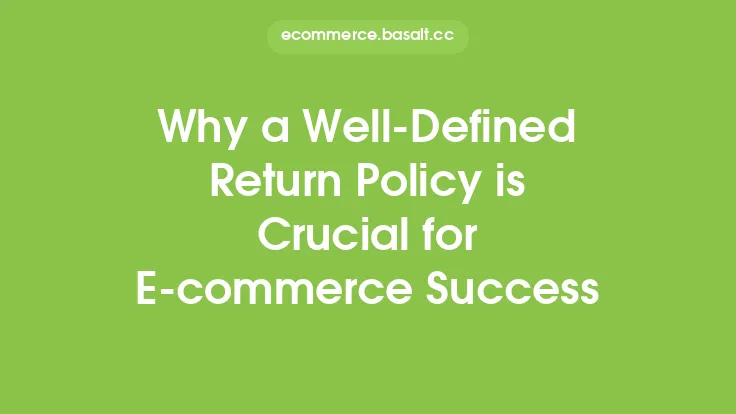When it comes to e-commerce, having a well-thought-out return and refund policy is crucial for building trust with customers and ensuring a positive shopping experience. Different e-commerce business models require unique considerations when it comes to return and refund policies. In this article, we will explore the various factors that e-commerce businesses should consider when developing their return and refund policies, depending on their specific business model.
Business-to-Consumer (B2C) Model Considerations
In the B2C model, e-commerce businesses sell products directly to individual consumers. When it comes to return and refund policies, B2C businesses should consider the following factors. Firstly, they should have a clear and concise return policy that is easily accessible to customers. This policy should outline the procedures for returning products, including the time frame for returns, the condition of the products, and any restocking fees. Secondly, B2C businesses should have a fair and flexible refund policy that takes into account the needs of their customers. This may include offering full or partial refunds, depending on the circumstances of the return. Finally, B2C businesses should ensure that their return and refund policies are compliant with relevant consumer protection laws and regulations.
Business-to-Business (B2B) Model Considerations
In the B2B model, e-commerce businesses sell products to other businesses. When it comes to return and refund policies, B2B businesses should consider the following factors. Firstly, they should have a return policy that is tailored to the needs of their business customers. This may include more flexible return procedures and longer return windows, as business customers may have different needs and requirements than individual consumers. Secondly, B2B businesses should have a refund policy that takes into account the volume and value of the products being returned. This may include offering credits or replacements rather than full refunds, depending on the circumstances of the return. Finally, B2B businesses should ensure that their return and refund policies are clearly outlined in their contracts and agreements with their business customers.
Direct-to-Consumer (D2C) Model Considerations
In the D2C model, e-commerce businesses sell products directly to consumers, bypassing traditional retail channels. When it comes to return and refund policies, D2C businesses should consider the following factors. Firstly, they should have a return policy that is designed to build trust and loyalty with their customers. This may include offering free returns, flexible return windows, and hassle-free refund procedures. Secondly, D2C businesses should have a refund policy that is transparent and easy to understand. This may include offering clear and concise information about refund procedures, including the time frame for refunds and any applicable fees. Finally, D2C businesses should ensure that their return and refund policies are aligned with their brand values and customer experience goals.
Subscription-Based Model Considerations
In the subscription-based model, e-commerce businesses offer products or services to customers on a recurring basis. When it comes to return and refund policies, subscription-based businesses should consider the following factors. Firstly, they should have a return policy that is tailored to the needs of their subscribers. This may include more flexible return procedures and longer return windows, as subscribers may have different needs and requirements than one-time customers. Secondly, subscription-based businesses should have a refund policy that takes into account the recurring nature of their business model. This may include offering prorated refunds or credits, depending on the circumstances of the return. Finally, subscription-based businesses should ensure that their return and refund policies are clearly outlined in their subscription agreements and terms of service.
Marketplace Model Considerations
In the marketplace model, e-commerce businesses provide a platform for third-party sellers to sell products to customers. When it comes to return and refund policies, marketplace businesses should consider the following factors. Firstly, they should have a return policy that is consistent across all sellers on their platform. This may include establishing minimum return policy standards for all sellers, as well as providing tools and resources to help sellers manage returns and refunds. Secondly, marketplace businesses should have a refund policy that is fair and transparent. This may include offering clear and concise information about refund procedures, including the time frame for refunds and any applicable fees. Finally, marketplace businesses should ensure that their return and refund policies are compliant with relevant consumer protection laws and regulations, and that they are clearly outlined in their terms of service and seller agreements.
International E-commerce Considerations
For e-commerce businesses that operate globally, return and refund policies can be even more complex. When it comes to international e-commerce, businesses should consider the following factors. Firstly, they should be aware of the different consumer protection laws and regulations that apply in different countries. This may include complying with regulations such as the European Union's Consumer Rights Directive, or the United States' Federal Trade Commission guidelines. Secondly, international e-commerce businesses should have a return policy that takes into account the logistics of international shipping and returns. This may include establishing partnerships with local returns handlers, or providing clear instructions for customers on how to return products from abroad. Finally, international e-commerce businesses should ensure that their return and refund policies are clearly outlined in multiple languages, and that they are accessible to customers in different countries and regions.
Technology and Automation Considerations
Finally, e-commerce businesses should consider the role of technology and automation in managing their return and refund policies. When it comes to returns and refunds, technology can help streamline processes, reduce errors, and improve the customer experience. For example, businesses can use automated returns processing systems to quickly and efficiently handle returns, or use data analytics to identify trends and patterns in returns and refunds. Additionally, businesses can use technology to provide clear and concise information to customers about return and refund procedures, such as through chatbots or FAQs on their website. By leveraging technology and automation, e-commerce businesses can create a more efficient, effective, and customer-friendly return and refund process.





